Before everyone who builds their own bath, the question arises, how to heat the water? Of course, you can not be puzzled by such a question, just putting a barrel of water in the steam room. The bathhouse is heated - the water is heated. This is what our ancestors did. In winter, the barrel was filled with snow, and then washed with melted water.
But progress is going forward, and you shouldn't wash your face with modern snow in the vicinity of megacities, the ecology is not the same now. Unless you can still collect pure snow in the remote Siberian taiga.
What options can be offered to the developer now, how to make the bath washing process comfortable and convenient? This will be discussed in the article.
Option selection
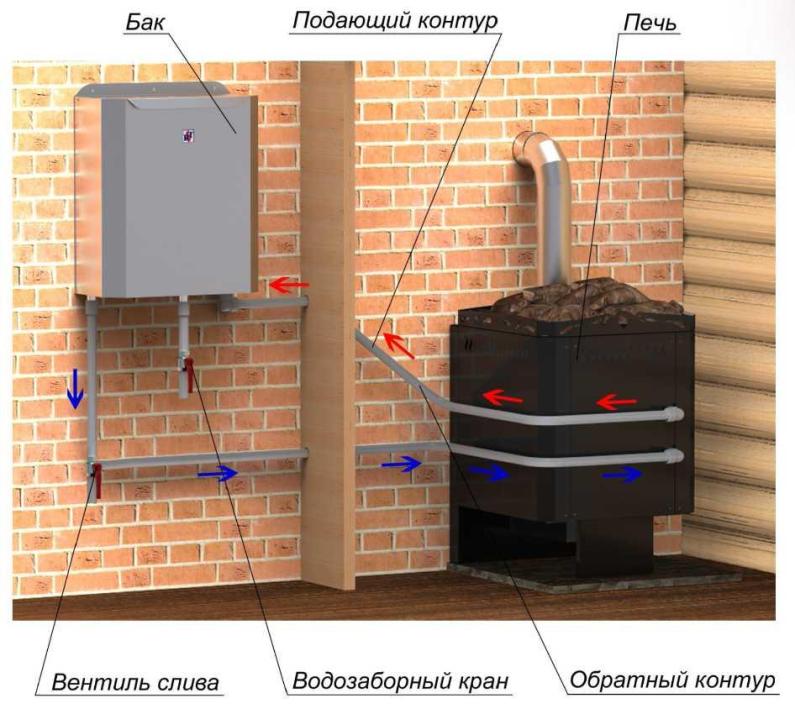
You can, of course, install an ordinary electric boiler in the washing compartment by running cold water to it. But what's the point of wasting electricity when you will heat the bath anyway.
By the location of the tank
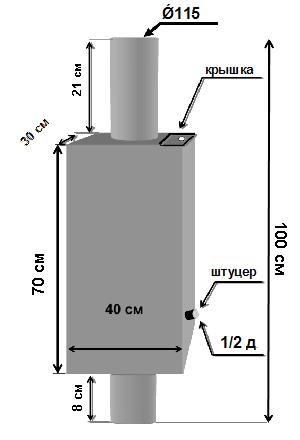
The tanks produced by our industry differ in their future location. They all have their own advantages and disadvantages.
They are:
- remote, they can be installed anywhere, and the water in them will be heated due to the presence of a heat exchanger in the furnace, cold water from the tank will fall into furnace heat exchanger, and the hot one will rise into the tank;
- built-in when the bottom of the container has direct contact with fire, and the tank itself is built in the bottom of the oven, a tap is made in it, from which you can pour boiling water;
- tanks on a pipe for a bath, the most ideal option, since the water in such a container will be hot for a long time, even if the stove is no longer heated.
Council. When choosing a tank option with placement on a pipe, you can choose a container of a sufficiently large volume, since the heating element itself can be used for its entire length.
Such a container can stretch from the stove, and sometimes even higher, capturing the attic space.
By materials of manufacture

Much depends on what material the tank for the bath on the pipe will be made of. This is the rate of water heating, the time the water remains warm, and the durability of the product.
Currently, containers are produced from the following materials:
- cast iron, this material has been used for a long time, the water in it heats up for a long time, it takes a lot of firewood, but the water in it cools very slowly, cast iron is not afraid of corrosion and high temperatures, but its disadvantage is its very large weight, which makes it difficult to use;
- enameled, such containers can be used as this tank cannot be installed;
- made of stainless steel, the most popular option today, especially when installed on a pipe, such tanks have excellent thermal conductivity, low coefficient of deformation from temperature extremes, they are easy to maintain and lightweight.
By volume
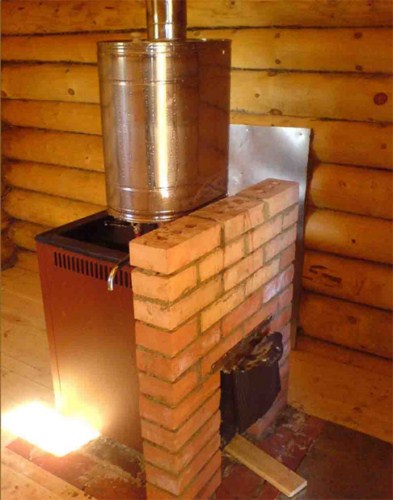
It is considered that a sufficient volume of a container with hot water for washing in a bath for one person is determined by the norm of 10 liters. To determine what capacity you need, the estimated number of people must be multiplied by 10 and we get the desired volume as a result.
But the following factors must be taken into account:
- if the stove is low-power, and the volume of the steam room is large, then in a large container the water will not have time to heat up;
- if the tank is too small, the water in it will boil off too quickly.
So, when choosing the required displacement, try to analyze and weigh all the information and stop exactly on the option that will satisfy each condition.
Advantages and disadvantages of samovar systems

A tub for a bath on a pipe is called a samovar. It is part of the chimney elbow. Its location is very convenient, much faster and more uniformly than in other locations, the process of heating the water takes place. The design itself is very compact.
The negative aspects of samovar systems include the fact that it is not very convenient to fill the tank with water. But this question can be easily solved if top part the tank is in the attic and has a water tap.
Important. It is very dangerous to make miscalculations in the design of the volume of the container, since it can result in very frequent boiling of water.
The material for the manufacture of samovar containers is usually stainless steel. The possibility, when using other materials, the occurrence of corrosion over time is detrimental to the normal operation of the bath, therefore the decision to install a stainless steel container is the right decision.
Among other things, the high thermal conductivity of stainless steel guarantees a fairly rapid heating of water in the samovar tank, and the strength of this material allows you not to be afraid of deformation of the device from temperature extremes.
Security
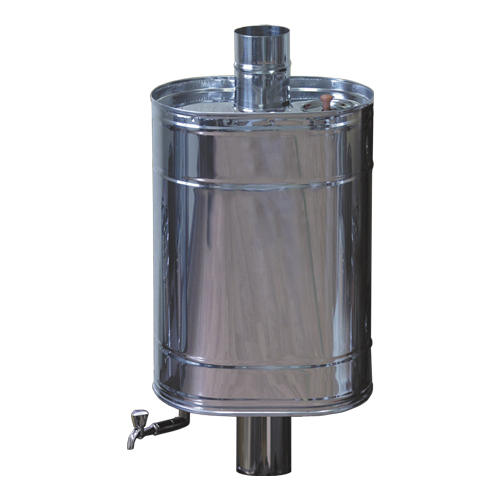
Today it is quite easy to find among the mass of proposals just such a vessel for heating water, which is exactly what you need. Craftsmen, of course, make them from old barrels with their own hands. But the price of ready-made options is not so high, and the reliability of these systems and durability force many to turn to certified products.
Do not forget that the bath is a place of increased danger. In it, you must strictly observe the precautions when handling hot water and fire. If you strictly follow the conditions specified in the operating instructions for the fuel tank, then you can avoid unexpected burns and injuries.
Important. It must be remembered that it is strictly forbidden to heat the stove with an empty tank, as the welded seams may disperse from the temperature.
It is also impossible to leave water in the system in winter if the bath is cold, since frozen water can rupture containers.
Summary
When choosing a suitable container for hot water in a bath, you must be guided by a number of conditions. When choosing a specific model of a tank for a chimney pipe, try to get the advice of a competent specialist. In the video presented in this article, you will find additional information on this topic.
Washing in a bath without hot water is simply unthinkable. Each problem of its heating solves in its own way: someone installs the vat on the stove, someone is more pleasant to use an electric water heater. However, do not forget that there are such stoves for a bath, which have in their composition or are adapted for the installation of special tanks for water, just providing its heating. Moreover, the specialists involved in bath equipment have developed containers that can be used to complement almost any model of existing bath stoves. That is why we decided to tell you about what possibilities of water heating can make the bath procedure more pleasant and comfortable.
Sauna stoves equipped with a remote tank
One of the most convenient options for heating water is the installation of remote tanks. Such a tank can simultaneously cope with two tasks:
- hot water supply to the bath washing compartment;
- providing hot water to sinks located in other rooms.
The huge advantage of the installed remote tank is that its presence permanently eliminates such an unpleasant situation when the firebox brings the water to a boil without having time to completely warm up the entire volume of the steam room, which results in the filling of the room with clubs of wet steam.
In addition, a remote tank is the only right solution for those who want to acquire not a Russian bath, but a sauna, the air of which must be extremely dry.
Usually, a remote tank made of stainless steel should be installed in a room next to the steam room. Heating of the water poured into it is provided by means of a heat exchanger mounted in a bath stove and connected to the tank using pipes.

To ensure the circulation of water without the use of pumps, the bottom of the tank must rise above the heat exchanger, sometimes called a register, by half a meter or a little more. To prevent obstacles to the circulation of water, it is necessary:
- install connecting pipes with a length not exceeding 3 m;
- for installation, select pipes with a diameter of one inch or more;
- ensure the absence of sagging pipes and their slope of the order of 2-5 °.
If one of these conditions is not met, it may be necessary to install a pump.
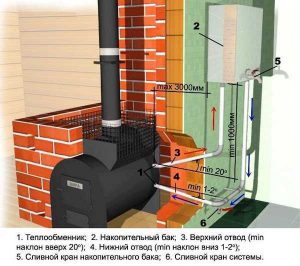
Speaking of heat exchangers, it should be noted that for furnaces of the "Heat" brand, for example, they are given a cylindrical shape, and for their manufacture stainless steel is used, the thickness of which is as much as 5 mm.
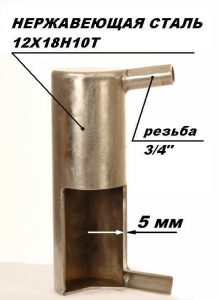
Convenient to use and practical remote tanks have, however, disadvantages, consisting in the complexity of their installation and connection. In addition, do not forget about the significant costs associated with the acquisition of rather expensive water heating registers, heat exchangers, pipes, taps, connecting hoses.
The listed disadvantages of remote-type tanks are largely compensated for by the convenient opportunity to equip a shower or connect a battery to the tank that can heat a locker room or shower in the winter cold.
Control tanks used with sauna stoves
The name of such tanks is due to the way they are installed, since they are placed directly on top of the firebox. It is quite understandable that manual tanks can be purchased in specialized stores, however, craftsmen often make them with their own hands, using the materials at their disposal: a piece of a thick pipe, sheets of metal, etc. When making such a tank on your own, special attention should be paid to the strength of the seams and the tightness of the tank during operation and installation.
Advice: If you buy a ready-made master tank, check the quality of all available welds. None of them should be burned out, which can adversely affect the durability of the entire product.
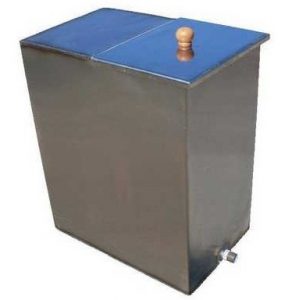
The bottom of the tanks may be uneven or have a recess to ensure its secure installation on the firebox. Such models can also be either purchased or made by yourself.
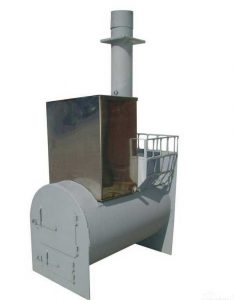
Chimney-mounted tanks
Pipe tanks are the most popular option. These products, due to their similarity with a well-known household item, are often referred to as samovar-type tanks. Their great advantage is that they practically do not take up the volume of the steam room.
These water heating tanks can be installed in different ways:
- tanks of round or square shapes are mounted on the chimney at a height of about half a meter above the upper plane of the furnace. Sometimes these containers even simultaneously play the role of passage nodes in the bath ceilings. The most cost-effective models of stoves with such tanks include the "Heat" model.

- installation of the tank in the premises of the second floor, as is done in the Varvara ovens. Such tanks can also be used as a pass-through unit in ceiling slab baths.

Heating water in samovar-type tanks can be done not only chimney, but also by the register installed in the firebox. This makes it possible to increase the volume of the tank and the water contained in it up to 120 liters, which, according to the manufacturer, can be heated in just one hour.
Another example of stoves, on all models of which samovar tanks can be installed, are products manufactured by the Termofor enterprise. One of them is "Tunguska", the tank of which is equipped with a water intake valve.
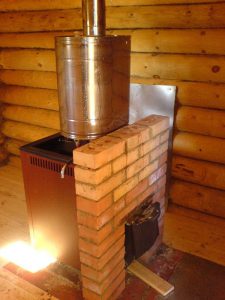
The shape of the pipe tanks can be different. An example of this is the Baikal tank with a cross-section reminiscent of the Reuleaux triangle.
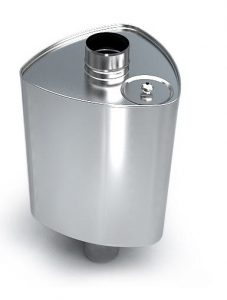
The volume of "Baikal" tanks can be different and range from 53 to 75 liters, the largest of which will cost about 5 thousand rubles.
Hanging tanks for sauna stoves
The convenience of the stoves provided for the use of hinged tanks is that the water heating tanks can be easily installed and also easily removed. As a rule, their suspension is provided by means of loops and hooks. Like all other water tanks, they are made of stainless steel. They include hatches for filling with water and taps that ensure the use of already heated water.
In the line of Vravra ovens there are several products intended for the installation of hinged tanks.
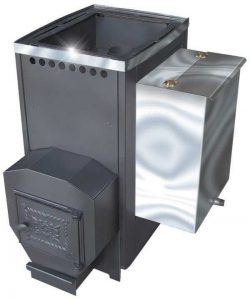
A significant drawback of such structures is that steaming people can burn themselves against their hot walls, and it is impossible to equip a shower using such tanks. In addition, the heated water can boil in them, causing abundant steam generation in the not yet fully heated steam room. True, the last problem can be solved in the following two ways:
- hanging the tank a little later;
- periodically draining hot water and replenishing the tank with cold water.

The convenience of hanging bins is that they are ideal for retrofitting existing furnaces. They are convenient in small spaces and in combination with small ovens. They, like the manual tanks, are easy to rinse and clean from the formed scale.
An excellent system was developed by Ermak specialists. Their tank can be used both as a mounted and remote, but subject to the purchase of a water heating register and the installation of a water supply circuit.
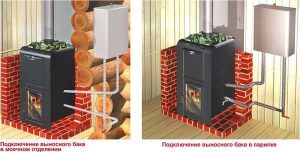
Our opinion on water tanks
In our opinion, the most convenient to use is. Once you spend money with its purchase and work hard with its installation, you will enjoy the comfort that this type of water heater can provide for a long time.
On the other hand, mounted and overhead tanks are attractive because of the simplicity of their installation. If we talk about tanks per pipe, then they allow you to save thermal energy, preventing heat from escaping along with the escaping smoke.
Thus, all types of tanks have their advantages and disadvantages. It is up to you to decide which of them is most acceptable, based on the conditions existing in your bath.
You can learn about some of the details of installing a remote tank from the following video:
In our culture, it is customary to treat the bath with special trepidation. The steam room has long ceased to be the only place for washing, but it still enjoys popular love. It is here that you can relax in body and soul, cleanse yourself of toxins, get rid of many diseases. To obtain soft, finely dispersed steam, it is necessary to install the correct sauna stove with a water tank. What are the criteria for choosing it? What are the models of industrial production and is it possible to make a structure with your own hands?
Why do you need a sauna stove with a water tank
The main function of the sauna stove is to warm up the steam room. If wet steam is needed, then additionally equip the heater. The stones are heated in it, which give hot steam after pouring water. A separate room is made for bathing - a washing room. Needed here hot waterso that you can wash off sweat and bathe in a comfortable environment.
If the bath is connected to the hot water supply at home, a water tank is not necessary. But if it must be supplied separately, then the tank is very desirable, otherwise you will have to heat the water for bathing. These are additional fuel costs. They can be easily avoided by installing the tank model right away.
Any stove can be equipped with a tank - gas, wood or electric. It can be made of steel, cast iron, brick or combined materials. The tank itself is made built-in, portable or hinged. For small baths, compact models with stoves and tanks are usually chosen or made.
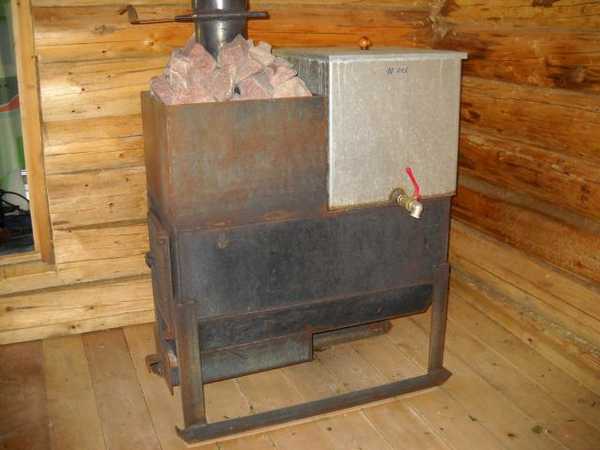
What is important to consider when choosing the right model
There are several factors that determine the intensity of heating the room and the quality of steam in the steam room. It is them that you should focus on when looking for the right stove:
- Power. This is the main criterion for choosing any heating device. The power should be sufficient for good warm-up, but not excessive, so as not to create unnecessary problems. When calculating, they are guided by the volume of the room. For heating 1 cbm. requires 1 kW of power.
- Type of fuel. It is necessary to choose a fuel that is always available in the area where the bath is located. Ideally, it should also be cheap. In gasified areas, this is not a problem, but nevertheless, many bath owners choose solid fuel models. This is a tribute to tradition. You can buy a structure that will be designed for both gas and firewood.
- Installation method. The type of heating depends on the location of the stove - from inside or outside the steam room. A model with a conventional combustion channel is suitable if it will be heated from a steam room. If you plan to kindle from a dressing room or a rest room, then it is better to choose a design with an elongated combustion channel.
- Design. The model should be easy to use and fit into the overall style of the bath design. The appearance of the stove cannot be attributed to the determining factors of choice, but still it is important, because any owner of a bath would like to equip a cozy place for rest and relaxation.
- Volume and type of water tank. Before purchasing, you should calculate the desired volume of the water tank and its location relative to the oven. For each specific room, you should choose a model, focusing on the layout. In some cases, the best solution would be to purchase a stove with a built-in heat exchanger.
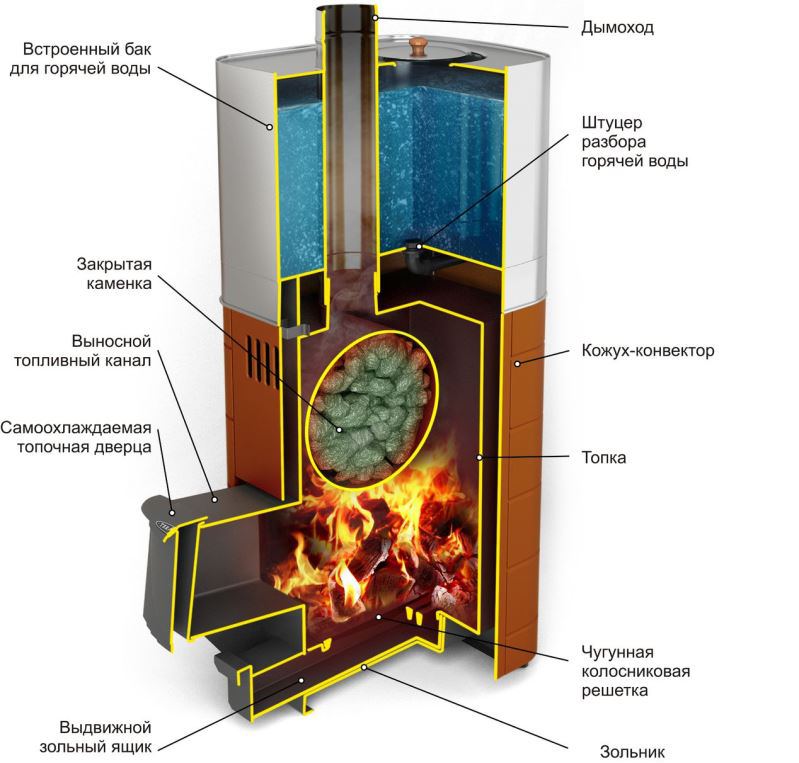
Furnace design diagram with built-in tank
What can be a water tank
When buying a sauna stove with a water tank, pay attention to its location and connection method. There are the following main types of tanks:
- Hinged. Located on the body of the model, it heats up as the walls of the stove warm up. There is an additional benefit: due to the reservoir, the area of \u200b\u200bthe heated surface increases. This is the easiest option in terms of installation, however, it will not work to organize a shower with such a tank, and the water heats up too quickly.
- The mentor. The water tank can be installed directly on the combustion chamber. This is not always convenient. Water can heat up much earlier than indoor air. In addition, the tank material can quickly burn out, and the seams can come apart.
- On the chimney pipe. This type of tank appearance resembles a samovar, so designs are often called samovar. The tank is attached to a pipe, and the water in it is heated by hot gases rising upward. This allows for more efficient use of fuel. Tanks are either square or round in shape. Often they are placed so that they serve as a gateway to the roof.
- Portable. Ideal for saunas, where the stove is in the steam room, and the tank should be located in the washing room. The water is heated with a built-in heat exchanger. Due to the design features of such a tank, a situation is excluded when the water is already boiling, and the room has not yet warmed up enough. The disadvantages include the high cost and complexity of installation in comparison with other types of tanks.
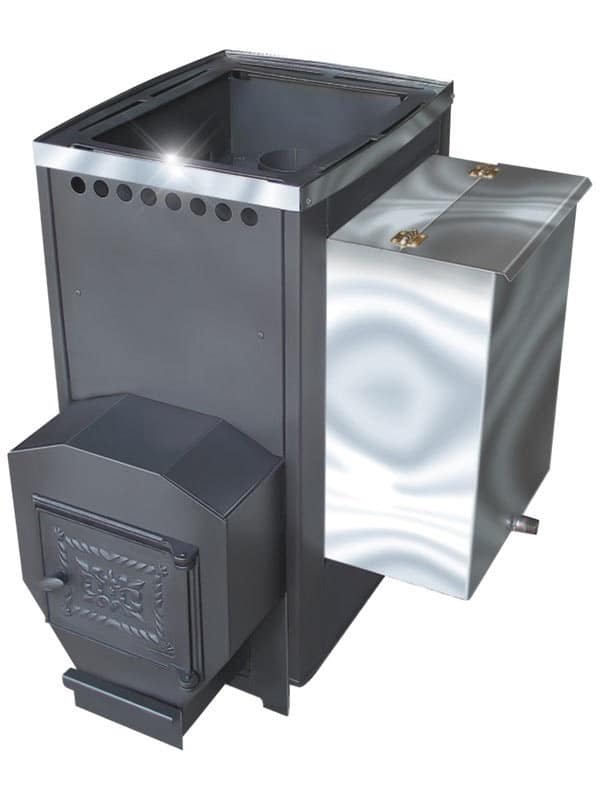
Model "Varvara" with a hinged tank
Homemade constructions of different types
There are several common modifications of stoves in a bath with a water tank. They are designed for rooms of different sizes and different operating conditions. We suggest considering options and choosing the most suitable one.
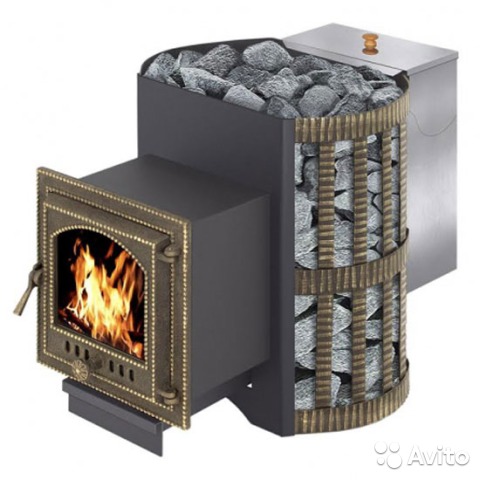
Option # 1: with a heat exchanger and a remote tank
Installing a remote tank is a guarantee that the steam room will not be filled with unnecessary raw steam, because water does not boil ahead of time. The design is an improved potbelly stove, in which a special register for heating water is located in the firebox, and a heater is located above the firebox.
The most convenient option for arranging a heater is an open metal mesh or pocket. A closed pocket will not work. the temperature is too high when steam comes out. This increases the risks for people in the steam room: you can get serious burns.
Sauna stove with remote tank can be purchased at finished form or do it yourself. For its manufacture, sheet steel with a thickness of 4-5 mm is suitable. It is better to take stainless steel for the register and reservoir. The tank should be mounted at a height of at least 0.5 m from the register, and connected to the register using pipes or hoses.
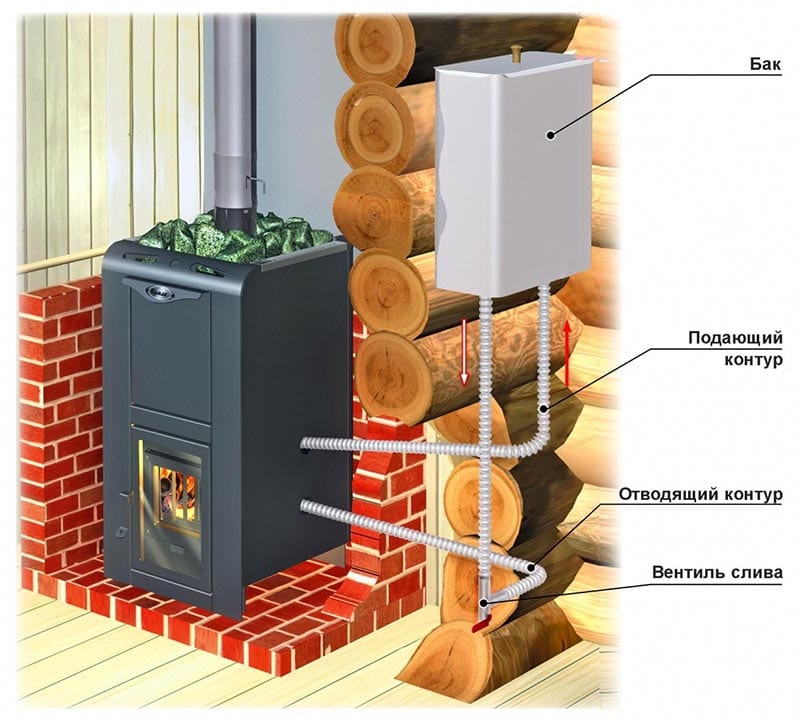
Diagram of a heater with a water tank
Option # 2: iron barrel heater
For the manufacture of a stove in a bath with a water tank and a stove, you can use a used iron barrel. The main thing is that it is not leaky and rusty. To obtain a metal cylinder, cut off the upper and lower parts, then install the grate.
Part of the structure is filled with bricks. They are installed on the edge. 2/3 of the space will be occupied by the heater. All that remains is to install the chimney and bring it to the roof. This design has a serious drawback. If it is not covered with a lid, gases enter the steam room. If you cover it, you will have to remove the lid every time you need to add steam.
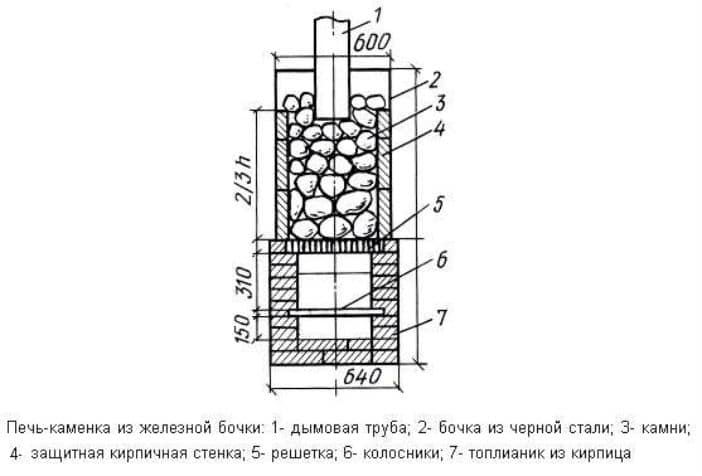
Diagram of a furnace from a barrel
Option # 3: sheet metal construction
You can make your own sauna stove with a tank from sheet metal 5-10 mm thick. This will require a detailed drawing. Theoretically, you can develop it yourself, but if you do not have the necessary skills, it is better to use the ready-made one. One of the successful options is suggested below:
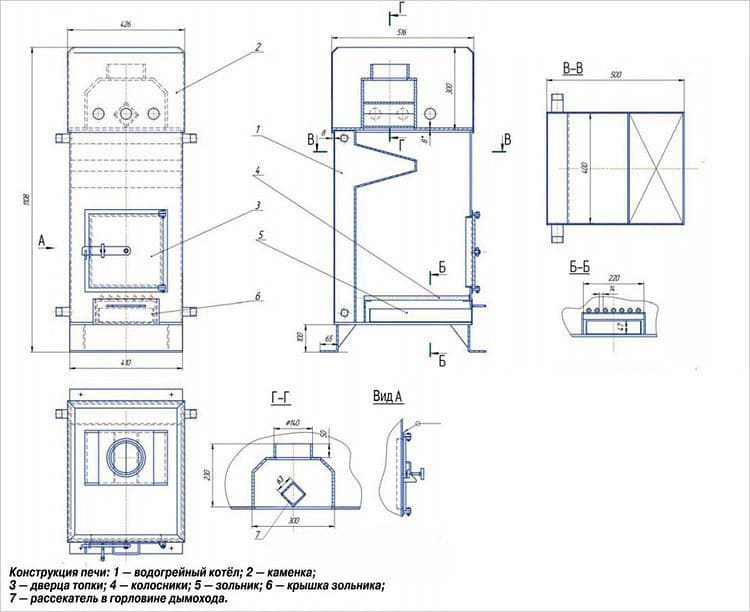
The finished drawing for the manufacture of the stove
The metal is cut in accordance with the drawing. To avoid mistakes, all elements are first cut from sheets of cardboard. These blanks are laid out on metal and the elements are outlined along them, after which they are cut with a grinder. The finished parts are welded.
Attention! The quality of the welds is of fundamental importance. If they are poorly made, the structure will quickly fail.
The oven is installed in the same way as other models. For the best quality of heating the steam room, you can put a brick screen at a distance of 15-20 cm from the structure.
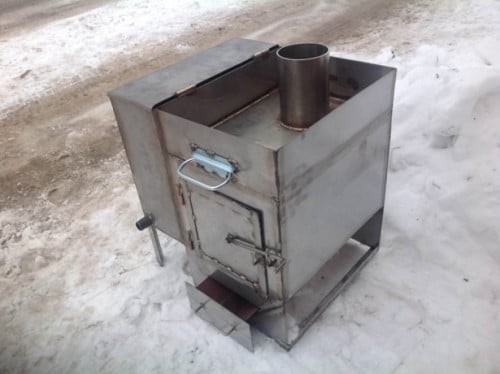
Factory furnaces for a bath with a tank
If the budget allows, it is better not to reinvent the wheel and buy a factory stove with a tank in the bathhouse. Manufactured designs are easy to install, fuel efficient and provide comfortable steam. There are models with combustion intensity control systems. This is very convenient because you can independently control the quality, amount of steam, warm-up time.
- "Tunguska". A good choice for sauna owners who are ready to pay 10,000 rubles. The location of the water tank is on the chimney.
- "Sahara". Suitable for both traditional steam rooms and saunas, since it is equipped with a steam converter. Heats stones quickly. The volume of the tank is 33 liters.
- Helo. A 22 l water tank is built into the structure body. To prevent the water from boiling, a temperature control system is provided.
Stoves "Varvara", "Charodeyka", Harvia are also in demand. The specific modification should be selected depending on the needs and preferences of the owner of the bath, the required power.
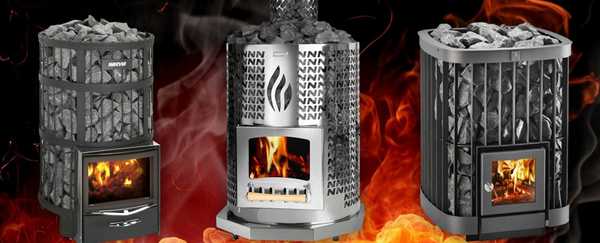
Harvia brand models
How to properly install the stove in the bath
Metal wood stoves do not require such a massive foundation as brick ones, but it is still advisable to make a base for them, if possible. A small structure is enough - 0.5 × 1.2 m.
For the foundation, a hole is made about half a meter deep, the bottom is tamped and covered with a layer of rubble 30 cm thick. A screed is made on top of the crushed stone pillow. When it dries, lay a waterproofer, pour concrete mortar... After hardening, the foundation is covered with a sheet of metal and the furnace is installed.

Foundation diagram for a bath stove
When assembling the stove, there are several important rules to remember:
- Under the structure, you need to allocate a platform with dimensions of 70x70 cm.
- The firebox door should "look" towards the door. The heater door is opposite to the opposite side of the door.
- Where the chimney comes out brickwork need to be made 12 cm thicker.
- If the floors of the bath are made of wood, they are protected with heat-insulating materials.
The technical documentation for each model of industrial production indicates the norms and rules that must be followed for the safe installation of the structure. Strict adherence to the manufacturer's recommendations is the key to the normal operation of the stove during the entire period of operation.
Do not ignore the instructions and do not need to use the documentation that comes with other models.
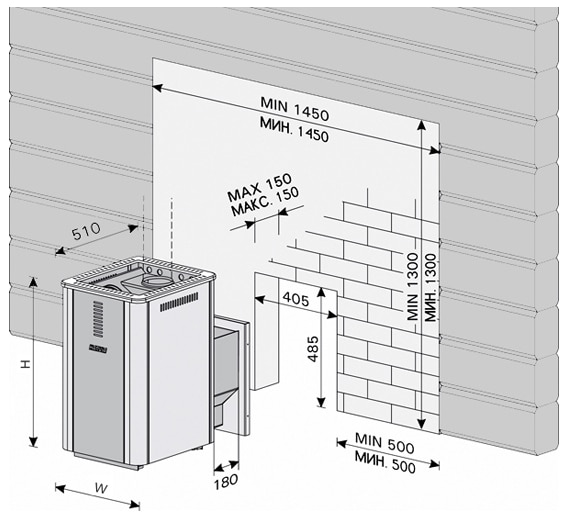
The layout of the stove in the bath
Video: do-it-yourself sauna stove
Wood stoves considered the most fire hazardous, but they are the most respected among the owners of the baths. If you choose such a model, take care of the proper level of security. The floor and walls near the stove must be covered with metal sheets or other non-combustible materials... Flammable objects must not be placed near the firebox. Adhere to the safety rules and worry about your health!




